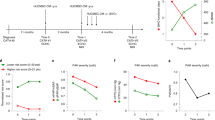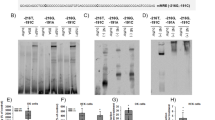Abstract
It has been shown that vascular endothelial cells functionally express a local circuit autocrine–paracrine regulatory pathway driven by endogenously expressed chemically authentic morphine, its cognate opiate alkaloid-selective mu3 and mu4 receptors, and constitutive nitric oxide (NO). Accordingly, the aim of the study was to examine morphine-mediated changes in hypertension-associated gene expression in two independent cell models: primary cultures of human white blood cells (WBCs) and human multilineage progenitor cells (MLPCs). In separate incubations, primary cultures of human WBC and MLPC were treated with morphine at a final concentration of 1 μ morphine for 2–4 h. After RNA extraction and reverse transcription, Human Genome Survey Arrays were used to construct and differentially analyze by strict statistical criteria transcriptional/gene expression profiles of WBC and undifferentiated human MLPC in three independent experiments. The Applied Biosystems Human Genome Survey Array contains 31 700 60-mer oligonucleotide probes representing a set of 27 868 individual human genes and >1000 control probes. After DNA microarray analyses, a variety of hypertension-associated genes from both cell types were observed to be significantly downregulated. The only genes expressed in both cell types were β-adrenergic receptor kinase 2 (ADRBK2) and coding protein kinase WNK1 (PRKWNK1); however, only PRKWNK1 showed downregulation of its expression after morphine exposure. Only two genes were observed to be significantly upregulated after morphine treatment: ADRBK2 in stem cells and β3-adrenergic receptor in WBC. Morphine administration to primary cultures of human WBC and MLPC altered the expression profile of 16 candidate hypertension-associated genes. The majority of relevant genes was observed to be downregulated, suggesting ongoing homeostatic regulation by endogenous morphine coupled to NO production and release. In sum, these data suggest a predominantly antihypertensive role for endogenous morphine/NO signaling events.
This is a preview of subscription content, access via your institution
Access options
Subscribe to this journal
Receive 12 digital issues and online access to articles
$119.00 per year
only $9.92 per issue
Buy this article
- Purchase on Springer Link
- Instant access to full article PDF
Prices may be subject to local taxes which are calculated during checkout



Similar content being viewed by others
References
Cadet P, Mantione KJ, Stefano GB . Molecular identification and functional expression of mu3, a novel alternatively spliced variant of the human mu opiate receptor gene. J Immunol 2003; 170: 5118–5123.
Stefano GB, Hartman A, Bilfinger TV, Magazine HI, Liu Y, Casares F et al. Presence of the mu3 opiate receptor in endothelial cells: Coupling to nitric oxide production and vasodilation. J Biol Chem 1995; 270: 30290–30293.
Stefano GB, Zhu W, Cadet P, Mantione K, Bilfinger TV, Bianchi E et al. A hormonal role for endogenous opiate alkaloids: Vascular tissues. Neuroendocrinol Lett 2002; 23: 21–26.
Zhu W, Bilfinger TV, Baggerman G, Goumon Y, Stefano GB . Presence of endogenous morphine and morphine 6 glucuronide in human heart tissue. Int J Mol Med 2001; 7: 419–422.
Zhu W, Cadet P, Baggerman G, Mantione KJ, Stefano GB . Human white blood cells synthesize morphine: CYP2D6 modulation. J Immunol 2005; 175: 7357–7362.
Liu Y, Bilfinger TV, Stefano GB . A rapid and sensitive quantitation method of endogenous morphine in human plasma. Life Sci 1996; 60: 237–243.
Brix-Christensen V, Tonnesen E, Sanchez RG, Bilfinger TV, Stefano GB . Endogenous morphine levels increase following cardiac surgery as part of the antiinflammatory response? Int J Cardiol 1997; 62: 191–197.
Boettcher C, Fellermeier M, Boettcher C, Drager B, Zenk MH . How human neuroblastoma cells make morphine. Proc Natl Acad Sci USA 2005; 102: 8495–8500.
Cadet P, Mantione KJ, Zhu W, Kream RM, Sheehan M, Stefano GB . A functionally coupled mu3-like opiate receptor/nitric oxide regulatory pathway in human multi-lineage progenitor cells. J Immunol 2007; 179: 5839–5844.
Kitsios GD, Zintzaras E . Synopsis and Data Synthesis of Genetic Association Studies in Hypertension for the Adrenergic Receptor Family Genes: the CUMAGAS-HYPERT database. Am J Hypertens 2010; 23: 305–313.
Delles C, McBride MW, Graham D, Padmanabhan S, Dominiczak AF . Genetics of hypertension: from experimental animals to humans. Biochim Biophys Acta 2009 (e-pub ahead of print; doi:10.1016/j.bbadis.2009.12.006).
Kohler R . Single-nucleotide polymorphisms in vascular Ca(2+)-activated K (+)-channel genes and cardiovascular disease. Pflugers Arch 2010; 460: 343–351.
Gluba A, Banach M, Mikhailidis DP, Rysz J . Genetic determinants of cardiovascular disease: the renin-angiotensin-aldosterone system, paraoxonases, endothelin-1, nitric oxide synthase and adrenergic receptors. In Vivo 2009; 23: 797–812.
Stefano GB, Salzet M, Magazine HI, Bilfinger TV . Antagonist of LPS and IFN-g induction of iNOS in human saphenous vein endothelium by morphine and anandamide by nitric oxide inhibition of adenylate cyclase. J Cardiovasc Pharmacol 1998; 31: 813–820.
Loguinov AV, Anderson LM, Crosby GJ, Yukhananov RY . Gene expression following acute morphine administration. Physiol Genomics 2001; 6: 169–181.
Mahinda TB, Lovell BM, Taylor BK . Morphine-induced analgesia, hypotension, and bradycardia are enhanced in hypertensive rats. Anesth Analg 2004; 98: 1698–1704.
Rudner XL, Berkowitz DE, Booth JV, Funk BL, Cozart KL, D'Amico EB et al. regulation of human vascular alpha(1)-adrenergic receptors by vessel bed and age. Circulation 1999; 100: 2336–2343.
Townsend SA, Jung AS, Gillian Hoe YS, Lefkowitz RY, Khan SA, Lemmon CA et al. Critical Role for the alpha-1B adrenergic receptor at the sympathetic neuroeffector junction. Hypertension 2004; 44: 776–782.
Gros R, Benovic JL, Tan CM, Feldman RD . G-protein-coupled receptor kinase activity is increased in hypertension. J Clin Invest 1997; 99: 2087–2093.
Park SJ, Choi DJ, Kim CW . Hypertensive left ventricular hypertrophy: relation to beta-adrenergic receptor kinase-1 (βARK1) in peripheral lymphocytes. J Hypertens 2004; 22: 1025–1032.
Bond RA, Bylund DB, Eikenburg DC, Hieble JP, Hills R, Minneman KP et al. Adrenoceptors: β3-adrenoceptor. IUPHAR database (IUPHAR-DB) http://www.iuphar-db.org/DATABASE/ObjectDisplayForward?objectId=30.
Dessy C, Moniotte S, Ghisdal P, Havaux X, Noirhomme P, Balligand JL . Endothelial â3-adrenoceptors mediate vasorelaxation of human coronary microarteries through nitric oxide and endothelium-dependent hyperpolarization. Circulation 2004; 110: 948–954.
Varghese P, Harrison RW, Lofthouse RA, Georgakopoulos D, Berkowitz DE, Hare JM . 3-adrenoceptor deficiency blocks nitric oxide–dependent inhibition of myocardial contractility. J Clin Invest 2000; 106: 697–703.
Rautureau Y, Toumaniantz G, Serpillon S, Jourdon P, Trochu JN, Gauthier C . Beta3-adrenoceptor in rat aorta: molecular and biochemical characterization and signaling pathway. Br J Pharmacol 2002; 137: 153–161.
Piechota M, Banach M, Jacoń A, Rysz J . Natriuretic peptides in cardiovascular diseases. Cell Mol Biol Lett 2008; 13: 155–181.
Irzmański R, Banach M, Piechota M, Kowalski J, Barylski M, Cierniewski C et al. Atrial and brain natriuretic peptide and endothelin-1 concentration in patients with idiopathic arterial hypertension: the dependence on the selected morphological parameters. Clin Exp Hypertens 2007; 29: 149–164.
Yokokawa K, Kohno M, Yasunari K, Murakawa K, Takeda T . Endothelin-3 regulates endothelin-1 production in cultured human endothelial cells. Hypertension 1991; 18: 304–315.
Newhouse SJ, Wallace C, Dobson R, Mein C, Pembroke J, Farrall M et al. Haplotypes of the WNK1 gene associate with blood pressure variation in a severely hypertensive population from the British Genetics of Hypertension study. Hum Mol Genet 2005; 14: 1805–1814.
Choate KA, Kahle KT, Wilson FH, Nelson-Williams C, Lifton RP . WNK1, a kinase mutated in inherited hypertension with hyperkalemia, localizes to diverse Cl—transporting epithelia. Proc Natl Acad Sci USA 2003; 100: 663–668.
Zambrowicz BP, Abuin A, Ramirez-Solis R, Richter LJ, Piggott J, Beltrandel-Rio H et al. Wnk1 kinase deficiency lowers blood pressure in mice: a gene-trap screen to identify potential targets for therapeutic intervention. Proc Natl Acad Sci USA 2003; 100: 14109–14114.
Moser D, Ekawardhani S, Kumsta R, Palmason H, Bock C, Athanassiadou Z et al. Functional analysis of a potassium-chloride co-transporter 3 (SLC12A6) promoter polymorphism leading to an additional DNA methylation site. Neuropsychopharmacology 2009; 34: 458–467.
Teggi R, Lanzani C, Zagato L, Delli Carpini S, Manunta P, Bianchi G et al. Gly460Trp [alpha]-adducin mutation as a possible mechanism leading to endolymphatic hydrops in Meniere's syndrome. Otol Neurotol 2008; 29: 824–828.
Hattori A, Kitatani K, Matsumoto H, Miyazawa S, Rogi T, Tsuruoka N et al. Characterization of recombinant human adipocyte-derived leucine aminopeptidase expressed in Chinese Hamster ovary cells. J Biochem 2000; 128: 755–762.
Seubert JM, Xu F, Graves JP, Collins JB, Sieber SO, Paules RS et al. Differential renal gene expression in prehypertensive and hypertensive spontaneously hypertensive rats. Am J Physiol Renal Physiol 2005; 289: F552–F561.
Hare JM, Colucci WS . Role of nitric oxide in the regulation of myocardial function. Prog Cardiovasc Dis 1995; 38: 155–166.
Glenn CL, Wang WYS, Morris BJ . Different frequencies of inducible nitric oxide synthase genotypes in older hypertensives. Scientific contributions. Hypertension 1999; 33: 927–932.
Singh A, Sventek P, Lariviere R, Thibault G, Schiffrin EL . Inducible nitric oxide synthase in vascular smooth muscle cells from prehypertensive spontaneously hypertensive rats. Am J Hypertens 1996; 9: 867–877.
Cui X, Rouhani FN, Hawari F, Levine SJ . An aminopeptidase, ARTS-1, is required for interleukin-6 receptor shedding. J Biol Chem 2003; 278: 28677–28685.
Takiyyuddin MA, Parmer RJ, Kailasam MT, Cervenka JH, Kennedy B, Ziegler MG et al. Chromogranin A in human hypertension. Influence of heredity. Hypertension 1995; 26: 213–220.
Takiyyuddin MA, Cervenka JH, Hsiao RJ, Barbosa JA, Parmer RJ, O'Connor DT . Chromogranin A: storage and release in hypertension. Hypertension 1990b; 15: 237–246.
O'Connor DT . Chromogranin A: implications for hypertension. J Hypertens 1984; 2 (suppl 3): 147–150.
Schober M, Howe PRC, Sperk G, Fischer-Colbrie R, Winkler H . An increased pool of secretory hormones and peptides in adrenal medulla of stroke-prone spontaneously hypertensive rats. Hypertension 1989; 13: 469–474.
Tsukada K, Ishimitsu T, Teranishi M, Saitoh M, Yoshii M, Inada H et al. Positive association of CYP11B2 gene polymorphism with genetic predisposition to essential hypertension. J Hum Hypertens 2002; 16: 789–793.
Curnow KM, Tusie-Luna MT, Pascoe L, Natarajan R, Gu JL, Nadler JL et al. The product of the CYP11B2 gene is required for aldosterone biosynthesis in the human adrenal cortex. Mol Endocrinol 1991; 5: 1513–1522.
Ylitalo A, Airaksinen KE, Hautanen A, Kupari M, Carson M, Virolainen J et al. Baroreflex sensitivity and variants of the renin angiotensin system genes. J Am Col Cardiol 2000; 35: 194–220.
Gluba A, Pietrucha T, Banach M, Piotrowski G, Rysz J . The role of polymorphisms within paraoxonases (192 Gln/Arg in PON1 and 311Ser/Cys in PON2) in the modulation of cardiovascular risk: a pilot study. Angiology 2010; 61: 157–165.
Gluba A, Banach M, Hannam S, Mikhailidis DP, Sakowicz A, Rysz J . The role of Toll-like receptors in renal diseases. Nat Rev Nephrol 2010; 6: 224–235.
Author information
Authors and Affiliations
Corresponding author
Ethics declarations
Competing interests
The authors declare no conflict of interest.
Rights and permissions
About this article
Cite this article
Banach, M., Casares, F., Kream, R. et al. Morphine-mediated alteration of hypertension-related gene expression in human white blood cells and multilineage progenitor cells. J Hum Hypertens 24, 713–720 (2010). https://doi.org/10.1038/jhh.2010.69
Received:
Revised:
Accepted:
Published:
Issue Date:
DOI: https://doi.org/10.1038/jhh.2010.69
Keywords
This article is cited by
-
Alteration of hypertension-related gene expression in human white blood cells and multilineage progenitor cells mediated by morphine
Journal of Human Hypertension (2010)



